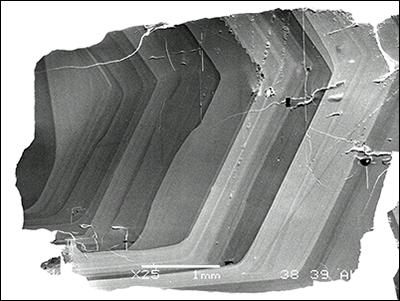Why Predicting Eruptions is Difficult and How to Improve It.
This long article, using Yellowstone as an example, describes current eruption prediction (earthquakes, ground deformation, gas discharge) and suggests better methods involving geophysics, (seismic tomography) and petrology (geospeedometry). And scientific drilling.
I had never come across the term geospeedometry before and the thought of drilling into a magma chamber gives this retired drilling engineer the willies! So I read the article and it is very interesting.
Apparently magma drilling "requires cooling the rock in front of the drill bit to quench a narrow cylinder of melt so that it can be further penetrated." What would you use? A liquid which did not vaporise? I will need to research this further.
There is a lot more of interest in the article - well worth reading.
Photomicrograph of sanidine from California’s Inyo Domes illustrating sharp growth zones. These zones track different episodes in the evolution of the magma surrounding these crystals as they grew. Credit: N. Matthews and J. Vazquez, USGS


No comments:
Post a Comment